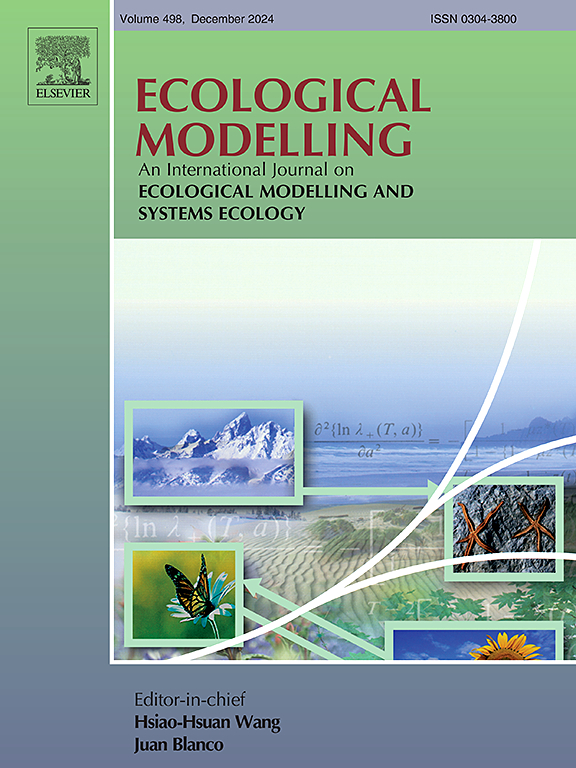Hybrid modeling approaches for accurate greenhouse climate prediction: Combining mechanistic models and LSTM neural networks
IF 2.6
3区 环境科学与生态学
Q2 ECOLOGY
引用次数: 0
Abstract
An accurate greenhouse climate model is crucial for controller design, energy consumption, and crop yield prediction. However, for a given greenhouse, considerable cost and time are required to study the thermal and mass transfer processes needed to construct an accurate greenhouse climate mechanistic model. To explore highly efficient modeling methods for greenhouse climate, this study proposes two hybrid modeling methods that combine mechanistic modeling with neural networks. The first method establishes a residual dataset for the greenhouse environment using mechanistic models and trains this residual model with an LSTM neural network. The second method employs LSTM neural networks and mechanistic models to predict greenhouse climate, then weights and combines the predictions from both models to achieve more accurate forecasting of greenhouse climate. In these two hybrid models, the mechanistic models use optimization algorithms for parameter identification and are validated with data from four different periods. A comparison of the results from the mechanistic model and the LSTM greenhouse climate prediction model shows that the neural network residual correction model exhibits better prediction accuracy and generalization capability in handling uncertain climate environment data. In contrast, the weighted fusion model places higher demands on the base models and shows considerable uncertainty in adaptability to different environments. The developed models in this study not only improve the prediction accuracy of greenhouse climate but also enhance the capability to handle complex and changing climatic conditions, thereby providing reliable decision-making support for greenhouse management and agricultural production.
温室气候精确预测的混合建模方法:结合机制模型和LSTM神经网络
一个准确的温室气候模型对于控制器设计、能源消耗和作物产量预测至关重要。然而,对于给定的温室,研究构建精确的温室气候机制模型所需的传热传质过程需要大量的成本和时间。为了探索高效的温室气候模拟方法,本研究提出了两种将机制模拟与神经网络相结合的混合模拟方法。第一种方法是利用机制模型建立温室环境残差数据集,并利用LSTM神经网络对残差模型进行训练。第二种方法采用LSTM神经网络和机制模型对温室气候进行预测,然后对两种模型的预测结果进行加权和组合,实现对温室气候更准确的预测。在这两种混合模型中,机械模型使用优化算法进行参数辨识,并使用四个不同时期的数据进行验证。机制模型与LSTM温室气候预测模型的结果对比表明,神经网络残差校正模型在处理不确定气候环境数据时具有更好的预测精度和泛化能力。而加权融合模型对基础模型的要求较高,对不同环境的适应性存在较大的不确定性。本研究建立的模型不仅提高了温室气候的预测精度,而且增强了应对复杂多变气候条件的能力,为温室管理和农业生产提供可靠的决策支持。
本文章由计算机程序翻译,如有差异,请以英文原文为准。
求助全文
约1分钟内获得全文
求助全文
来源期刊

Ecological Modelling
环境科学-生态学
CiteScore
5.60
自引率
6.50%
发文量
259
审稿时长
69 days
期刊介绍:
The journal is concerned with the use of mathematical models and systems analysis for the description of ecological processes and for the sustainable management of resources. Human activity and well-being are dependent on and integrated with the functioning of ecosystems and the services they provide. We aim to understand these basic ecosystem functions using mathematical and conceptual modelling, systems analysis, thermodynamics, computer simulations, and ecological theory. This leads to a preference for process-based models embedded in theory with explicit causative agents as opposed to strictly statistical or correlative descriptions. These modelling methods can be applied to a wide spectrum of issues ranging from basic ecology to human ecology to socio-ecological systems. The journal welcomes research articles, short communications, review articles, letters to the editor, book reviews, and other communications. The journal also supports the activities of the [International Society of Ecological Modelling (ISEM)](http://www.isemna.org/).
 求助内容:
求助内容: 应助结果提醒方式:
应助结果提醒方式:


